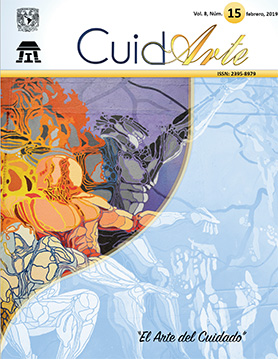Cognitive and process skills ins screening for cervico-uterine cancer
Main Article Content
Abstract
Downloads
Article Details
Citas en Dimensions Service
References
(1) DOF: Diario Oficial de la Federación [Internet]. México: DOF; 1994 [última actualización en 2007, consultado 17 oct. 2017]. NOM-014-SSA2-1994, Para la prevención, detección, diagnóstico, tratamiento, control y vigilancia epidemiológica del cáncer cérvido uterino; 1-19 Disponible en: https://bit.ly/2sJzVbA
(2) OMS: Organización Mundial de la Salud [Internet]. Washington DC: OMS; 2016 [consultado 18 Oct. 2017]. Control integral del cáncer cervicouterino: guía de prácticas esenciales, 2ª ed. 1-194. Disponible en: https://bit.ly/2k0pCvl
(3) Gob.mx [Internet]. México: Secretaria de salud; 2015 [consultado 18 Oct. 2017]. Información estadística: Estadísticas de Cáncer de Mama y Cáncer Cerviño Uterino [aprox. 3 pantallas]. Disponible en: https://bit.ly/2GXSoZT
(4) Ramos G, Díaz MC, Rodríguez JR, Domínguez FG. Citología Cervical satisfactoria: extendido exocervical circular comparado con longitudinal. Rev Med Inst Mex Seguro Soc [Internet]. 2014 [consultado 19 oct. 2017]; 52 (6): 696-703. Disponible en: https://bit.ly/2SAC3mr
(5) Cámara de Diputados del H. Congreso de la Unión [Internet]. México; 2010 [consultado 16 oct. 2017]. Ley Federal de Protección de datos personales en posesión de particulares; 1-18. Disponible en: https://bit.ly/1vauawz
(6) National Institutes of Health [Internet]. Comisión Nacional para la Protección de los sujetos humanos de investigación biomédica y comportamental; 1979 [consultado 19 oct. 2017]. Informe Belmont: Principios y guías éticos para la protección de los sujetos humanos de investigación; 1-12. Disponible en: https://bit.ly/1CW1hs7
(7) UNAM: Universidad Nacional Autónoma de México [Internet]. México: UNAM; 2014 [consultado 01 Oct. 2017]. Disponible en: https://bit.ly/2GxTyxf
(8) Álvarez AC. ¿Qué sabemos de la relación entre la teoría y la práctica en la educación? Revista iberoamericana de la educación [Internet]. 2012 [consultado 01 Oct. 2017]; 60 (2). Disponible en: https://bit.ly/2SuAvLz
(9) Fundación UNAM [internet]. México: fundación UNAM; 2013 [consultado 01 Oct. 2017]. Disponible en: https://bit.ly/2GAqYLI
(10) BlueBBVA [Internet]. México: bluemagazine; 2016 [consultado 02 Oct. 2017]. Disponible en: https://bit.ly/2NyYFRy
(11) Facultad de medicina de la UNAM [Internet]. México. Departamento de integración de ciencias médicas; [consultado 18 Oct. 2017]. Citología cervical; 1-16. Disponible en: https://bit.ly/2SGUZ2M
(12) Fundación UNAM [internet]. México: fundación UNAM; 2013 [consultado 01 Oct. 2017]. Disponible en: https://bit.ly/2DxODZN
(13) Vargas MR. Diseño curricular por competencias. [Internet]. 1ª ed. México: ANFEI; 2008. [Consultado 06 Oct. 2017]. Disponible en: https://bit.ly/2h72CeN
(14) Valles A. Formación en competencias y certificación profesional. 1ª ed. México: Iisue; 2014.
(15) Loustalot LM, Espinosa RR, Blas RI, Vite PG, Jerezano RO. Manual de procedimientos para la toma de la muestra de citología cervical. [Internet]. 1ª ed. México; 2006. [Consultado 18 Oct. 2017]. Disponible en: https://bit.ly/1QoGzhq

